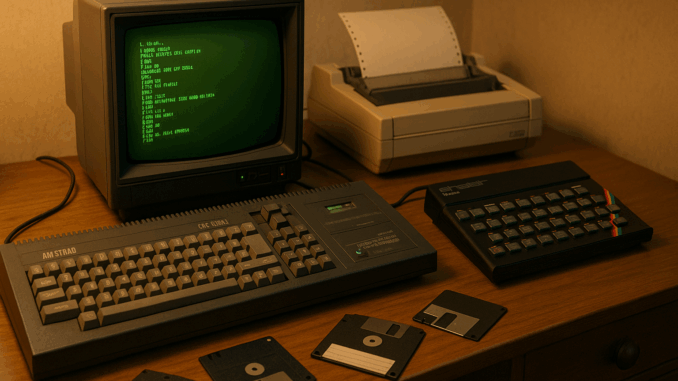
Back in the ’80s, if you wanted to look professional, you didn’t need a laser printer or Microsoft Word. You needed a decent home word processor, a willing dot-matrix printer, and the patience of a monk. It was a time when the clatter of keys and the screech of a Centronics port were the soundtrack to productivity. In this shootout, we’re revisiting the software stars that turned humble home micros into literary warhorses.
The Contenders
We’re focusing on British-market software from the heyday of the 8-bit home computer. Our candidates:
- Tasword (ZX Spectrum, Amstrad CPC, C64, more)
- Brunword (Amstrad CPC 6128, ROM & disk versions)
- Protext (Amstrad CPC/PCW, Atari ST, DOS)
- Wordwise / Inter-Word (BBC Micro)
- Mini Office II Word Processor (Various 8-bit platforms)
Let’s see how they stack up.
Interface & Usability
Tasword impressed with its 64-column display mode on a ZX Spectrum—a feat in itself. It used control-key combos for everything. If you liked playing Twister with your fingers, you’d feel at home.
Brunword, by contrast, made a leap with its cartridge-based ROM version on the CPC 6128. Instant loading, a cleaner interface, and nicely labelled menus (for the era). It felt semi-pro.
Protext was a revelation for speed typists: fast, full-screen editing, and macro scripting made it a beast for larger documents. Though spartan in presentation, it was laser-focused on getting text down.
Wordwise on the BBC Micro? Lightning-fast and deeply beloved in schools, despite its arcane control codes. Teachers swore by it, and pupils feared mistyping a SAVE command. Inter-Word softened the blow later with on-screen menus, bringing relief to many aching fingers.
Mini Office II‘s word processor was functional but basic—suitable for homework, not dissertations. It was a Swiss army knife more than a scalpel, but for many users, it was all they had—and it got the job done.
Formatting & Features
Tasword offered justification, headers, margins, and even block operations. It was a powerhouse in its later versions (Tasword Three), though you had to wrestle with control codes for every tweak.
Brunword earned praise for its justified text, smart spacing after punctuation, and decent block editing. Printer support was excellent too, especially with the Elite MK4 ROM.
Protext was a pro’s tool—search/replace, macros, auto-correction, and printer drivers galore. Its mail merge with Prodata was practically desktop publishing.
Wordwise was minimalist: no frills, just raw typing speed. Inter-Word added rudimentary formatting and help prompts. But compared to Protext? Apples and oranges.
Mini Office II had rudimentary formatting—bold and underline if your printer agreed—but that’s about it. Still, for a bundled suite that included database, spreadsheet, and graphics modules, it was astonishing value.
Storage & Printing
Tape vs Disk was a real divide. Tasword supported both, but tape loading was a nail-biter. Brunword’s ROM edition booted in seconds—a huge win. Disk versions of Protext and Brunword allowed quicker save/load cycles and supported multiple file slots.
Printer support often meant deciphering escape codes. Brunword and Protext shined here, with adaptable output formats and robust drivers. Tasword did a solid job, though configuration could be fiddly.
Verdicts by Category
| Category | Winner |
|---|---|
| Ease of Use | Brunword (ROM version) |
| Power Features | Protext |
| Best for ZX Spectrum Owners | Tasword |
| Educational Staple | Wordwise |
| Best Value All-Rounder | Mini Office II (bundle appeal) |
Honourable Mentions
- The Last Word (C64) – Advanced but niche.
- Desktop (ZX Spectrum, Czech import) – Surprisingly sophisticated.
Final Thoughts
These word processors weren’t just tools—they were companions for countless users typing CVs, school reports, and even novels late into the night. While today’s apps auto-format and cloud-save, the discipline these 8-bit titans demanded taught a generation to value the process of writing.
If you ask me? I’ll still take Tasword on a rainy evening with a mug of tea and the clatter of keys echoing like home. Just don’t ask me to format a footnote.
Bonus Comparison: Then vs Now
Tasword used commands like CTRL+P to toggle print mode or CTRL+J for justification. Fast forward to 2025 and Google Docs has CTRL+B for bold, CTRL+SHIFT+E for centre align. We’ve come a long way—but have we lost something in the process?
Which word processor did you swear by—or swear at? Let us know on Mastodon or in the BBS revival forum!

Leave a Reply